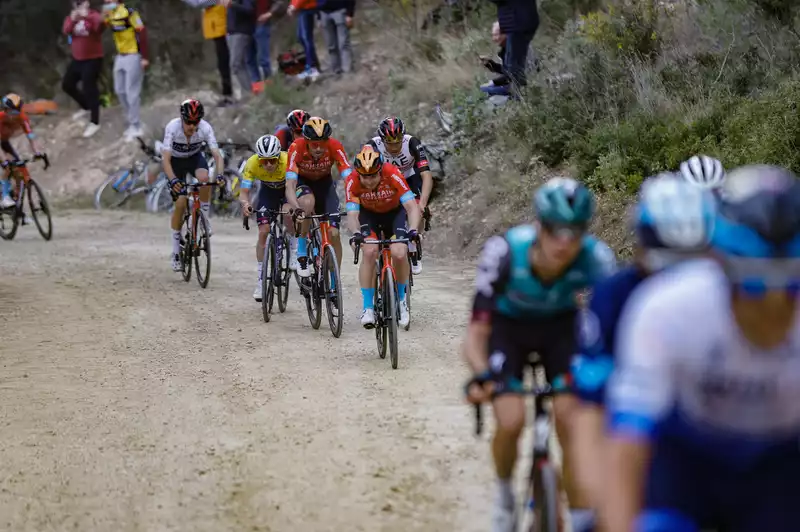Remco Evenepoel's criticism of a section of the off-road race at the Volta a la Comunitat Valenciana on Friday sparked further discussion about the growing trend of introducing stellar gravel roads in road races.
After losing the race lead to Alexandre Vlasov (Bora-Hansgrohe) in the uphill finish of the Antenas del Maigmo on stage 3, Evenepoel then stressed that Vlasov deserved the win and had taken the lead fair and square. However, he was scathing in his criticism of Valenciana's unprecedented introduction of the Stellato section, saying that it was "approaching mountain biking," that the race was already hard enough, and that the Stellato contributed nothing to the "beautiful race."
Evenpoel also claimed that the peloton in general has mixed feelings about the introduction of gravel sections
, saying that "the gravel is not a good thing. There is always a risk, he argued, "because tires can go flat.
At the start of the fourth stage of La Valenciana in Orihuela, the riders and management were divided on the use of Stellato in the crucial stage.
"I don't like to see gravel in a stage race," Matteo Trentin (UAE Team Emirates) told Cycling News after teammate and GC contender Juan Ayuso suffered mechanical problems in a gravel sector corner. "I think we are going too far, to a spectacle that is not necessary."
"Strade Bianche is Strade Bianche, it is a race that was born and developed that way. Also, the roads of Tuscany are different and special from other gravel roads in Italy."
"Rather than that, this race is something we need.
"Maybe it's better to find something special for this race than to try to recreate it."
Regarding the specific drawback of the final 6-kilometer ascent of stage 4, with nearly 2 kilometers of rough gravel road, Trentin claimed that "it was already steep enough and the surface was not good enough. It was not suitable for road racing. This was road cycling, not gravel racing."
Regarding the Evenpoel comparison, Trentin said: "[Yesterday] may not have been a mountain bike race, but it was certainly a gravel race. If you want to find gravel racing, there are circuits for that."
Like Ayuso, Alejandro Valverde (Movistar) also suffered mechanical problems with a flat tire on Stellato.
"I don't think the race was worth anything because the climbs were super hard and the stronger riders won. The only positive thing that happened was that it happened to riders like Ayuso. Punctures and technical accidents can happen on any surface.
Trentin also mentioned the inclusion of the Paris-Roubaix cobbled section in the Tour de France.
"It's difficult enough as it is, and in the past many GC contenders have suffered major defeats on the cobbled sections. But there is a reason why there are Grand Tour riders and classic riders. You can't mix the two."
This experienced Italian racer has done much to keep his riders safe. He argued that stage racing and gravel should not be mixed for safety reasons.
"Crashes are bound to happen. It was the same in the Tour a few years ago. There were more crashes than anything else. I don't know if that is a real plus or if it would be better to create another one-day race."
Trentin even argued that Paris-Tour, which recently added an off-road section to the finale, did not need to pass through the fields and vineyards of central France to be a good race.
"Why add something that is now fashionable when it is not a Paris-Tour tradition? "
Rick Verbrugghe, former Fresh Wallonne winner and director of Israel Startup Nation, agreed with Evenpoel.
"Nothing will change in the overall standings. The only risk is getting a flat tire. So although it is interesting at times, I think it is better to use it in the Strade Bianche instead of a stage race."
"First of all, for the safety of the rider, it is not a real sporting decision, but the possibility of losing the race because of a puncture or bad luck.
"OK, Lemko lost his jersey and it would have been the same result with or without gravel. Valverde got a puncture. It's a lot of pressure for nothing. So it's nice to have gravel in the race, but not all races have gravel."
For all-rounders like Chad Haga (Human Powered Health), gravel sections in stage races have both positive and negative aspects.
"I'm not totally against it; I think it can be a fun element at times," he said. Especially if it's a way to connect parts of the course that couldn't be connected any other way."
For example, in the 2019 Vuelta a España in the Pyrenees, an off-road section was used to connect the two climbs of the finale.
However, "I felt it wasn't necessary on Friday," Haga reasoned. We took the pavement to get to the team bus." I hit the pavement to get to the team bus."
"It wasn't necessary, but it wasn't detrimental either. It was just another thorn in the side of an already difficult day. But in general, I think it's an interesting element to add to the race."
While heartened by the organizers' eagerness to incorporate new elements into the event, Haga, who described Friday's gravel sector as "a bit squishy in places," agreed that the gravel section should remain a one-day race rather than a stage race He agreed with Trentin.
"The one-day race is already an all or nothing situation. In a stage race, you have more to lose. But there are arguments on both sides."
He said.
He partially conceded Evenpoel's claim of the peloton's dissatisfaction with the stellato section.
"There is some grumpiness among some riders, but every organizer wants to find something that makes the race exciting and attracts viewers. That's what the sport is all about
.

Comments